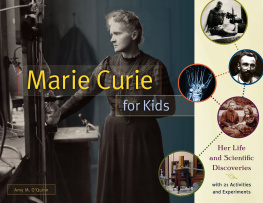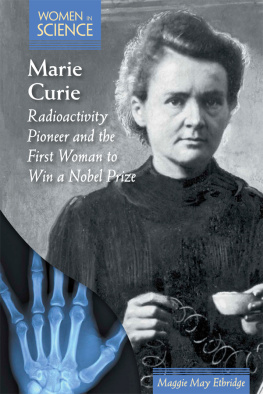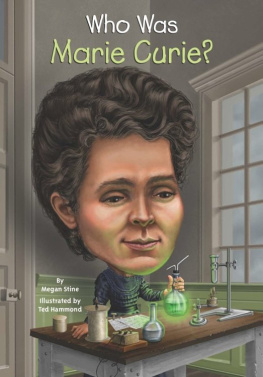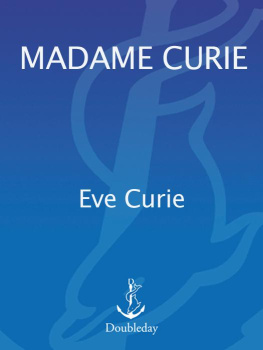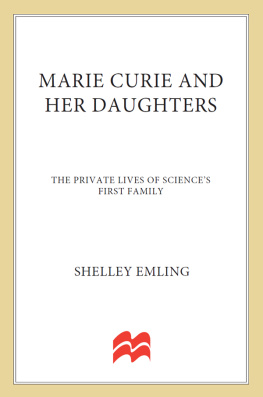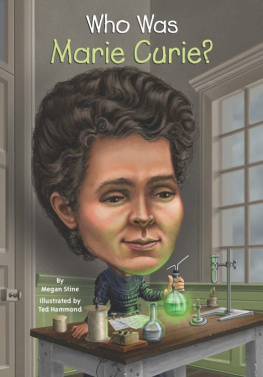EVA HEMMUNGS WIRTN is professor of mediated culture at Linkping University, Sweden. She is the author of Terms of Use: Negotiating the Jungle of the Intellectual Commons and No Trespassing: Authorship, Intellectual Property Rights, and the Boundaries of Globalization.
All rights reserved. Published 2015.
ISBN-13: 978-0-226-23584-4 (cloth) ISBN-13: 978-0-22623598-1 (e-book) DOI: 10.7208/chicago/9780226235981.001.0001
Library of Congress Cataloging-in-Publication Data Hemmungs Wirtn, Eva, author.
Making Marie Curie : intellectual property and celebrity culture in an age of information / Eva Hemmungs Wirtn.
pages ; cm. (Science.culture)
Includes bibliographical references and index.
ISBN 978-0-226-23584-4 (cloth : alk. paper) ISBN 0-226-23584-X (cloth : alk. paper) ISBN 978-0-22623598-1 (e-book) 1. Curie, Marie, 18671934. 2. Women chemistsFrance. 3. CelebritiesFrance. 4. Women in science. 5. Intellectual propertyHistory. I. Title. II. Series: Science.culture.
This paper meets the requirements of ANSI / NISO Z39.48-1992 (Permanence of Paper).
The result was something of a foregone conclusion. Marie Curie (18671934) demolished the competition, beating her runner-up Rosalind Franklin with double the number of votes. By virtue of having discovered and later isolated radium, and then coining the term radioactivity for the new science she and her husband Pierre introduced to the world, Curie remainsalong with Albert Einsteinthe most instantly recognizable face of modern science. So far the only woman twice awarded the Nobel Prize, her 1903 and 1911 distinctions assure her a permanent seat on the Mount Olympus of science.
Children read about Marie Curies accomplishments in school, learning just how far perseverance and commitment can take you. For each new generation, the same lesson applies: the sky is the limit, even for girls. Countless adolescents who dream about Life in the Laboratory consider the Polish-French scientist a role model. Curies private and professional life continues to fascinate and supply steady demand for new biographies. No textbook, dictionary, or exhaustive encyclopedia of twentieth-century sci
Admired, revered, idolized. Character-wise, there is no end in sight to the praise. But what about her contribution to science? Here, the verdict is less honorific. Laurent Lemire, one of Curies French biographers, suggests that she might be the victim of an Anglo-Saxon depreciation logic fueled by cultural incomprehension and competition. Be that as it may. If we apply Mertons potential to become an eponyma name powerful enough to label an entire epochs worth of knowledgeas a standard, then we will be limited to a very small sample of people. And they would all be men.
In contrast to Newton, Darwin, Freud, Einstein, Keynes, or any other Great Male Scientist targeted for a storyline using The Man to get at The World, Curie resists abstraction. The male scientist, for all his idiosyncrasies, retains his ability to function as a catalyst for generalizable observations about science. He fits, even as a misfit. Curie, on the other hand, circulates in the closed loop reserved for a specific historical actor, whose experience as a woman is so extraordinary that it cannot be abstracted or generalized. As a result, the only story Marie Curie can tell us is the one about her. Period. Compared to a sad Mary Poppins, labeled the Edith Piaf of radioactivity, even likened to Victor Hugos Cosette, Curie may be malleable enough to be anyone, real or fictitious, as long as she stays unique, one-of-a-kind, beyond comparison. As much as possible, I have tried to resist any diminishing logic that situates her as a woman first, a person only second, and a catalyst for generalizable observations on the conditions of modern science a distant third.
We make room for Marie Curie in our collective consciousness for all sorts of reasons. My own motives never included trying to unearth the real Curie behind a centurys worth of representational bounty. Authenticity searches are hopelessly quixotic to begin with, but even more to the point, I have never considered the representational bounty surrounding Curie a curtain hiding something really interesting. As the title suggests, my concern is precisely with the work that has gone into (and that continues to go into) the making of Marie Curie. This means recognizing that the hybrid traces of laboratory notebooks, articles, papers, patents, legal doctrine, advertising, penny press clippings, and popular science articles as well as the polls, encyclopedias, top-ten lists, biographies, and biopics are as relevant to the ongoing cultural construction of Curie as any biographical (or even scientific) so-called fact.
The inspiration for this book is straightforward enough. It can be traced back to my longstanding interest in the contentious role of intellectual property in late modern society. An interest historically motivated, not because I expect the past to serve up neat answers to the predicaments of the present, but because I share Steven Shapins belief that we write about the past as an expression of present concerns and that we can write about the past to find out about how it came to be that we live as we now do, and, indeed, for giving better descriptions of the way we live now.
But exactly what does a scientific life look like today? And how can someone like Marie Curie possibly tell us something new about it? My answer will come in the shape of the three combinable motifs that structure the narrative of this book: the impact of intellectual property in the domain of science and research; the emergence of celebrity culture and its role in shaping the image of the scientist; and finally, the question of how to organize scientific information as part of the modern infrastructure of knowledge. Although other choices could have been made, I take these three concerns to be central to contemporary scientific life. So they were to Marie Curies. Simply put, it is my hope that the juxtaposition of these three entities does end up giving a better description of the way we live now.
Intellectual property has become ubiquitous throughout the academy, despite a long history of being considered ideologically antithetical to traditional academic values of openness and sharing. Patents focus on innovation, trademarks on information, and copyright primarily on cultural expressions: together they constitute the benchmark regulation regime for universities and higher education. But this is only the benchmark formal regulation regime, because as in all social relations, the law does not reach every-where. Informal codes of conduct and norms continue to have a presence in university culture and beyond. Nonetheless, lengthy negotiations regarding the scope of the Big Threealone or in combinationawait any scientist embarking on a new project, whether slotted in the pure or applied category. From publish-or-perish to patent-or-perish, a jungle of licenses, trade secrets, and confidentiality agreements has increasingly turned laboratories into walled and privatized spaces within universities.



